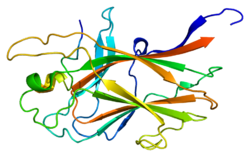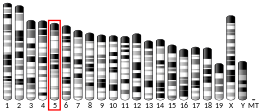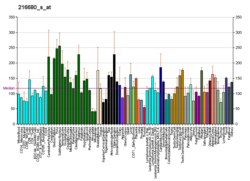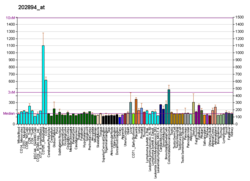EPH 수용체 B4
EPH receptor B4| EPHB4 | |||||||||||||||||||||||||
|---|---|---|---|---|---|---|---|---|---|---|---|---|---|---|---|---|---|---|---|---|---|---|---|---|---|
 | |||||||||||||||||||||||||
| |||||||||||||||||||||||||
| 식별자 | |||||||||||||||||||||||||
| 별칭 | EPHB4, Ephb4, AI042935, HTk, MDK2, Myk1, Tyro11, EPH 수용체 B4, HTK, MYK1, TYRO11, HFASD, CMAVM2, LMPM7 | ||||||||||||||||||||||||
| 외부 ID | OMIM: 600011 MGI: 104757 호몰로진: 20939 GeneCard: EPHB4 | ||||||||||||||||||||||||
| |||||||||||||||||||||||||
| |||||||||||||||||||||||||
| |||||||||||||||||||||||||
| |||||||||||||||||||||||||
| 직교체 | |||||||||||||||||||||||||
| 종 | 인간 | 마우스 | |||||||||||||||||||||||
| 엔트레스 | |||||||||||||||||||||||||
| 앙상블 | |||||||||||||||||||||||||
| 유니프로트 | |||||||||||||||||||||||||
| RefSeq(mRNA) | |||||||||||||||||||||||||
| RefSeq(단백질) | |||||||||||||||||||||||||
| 위치(UCSC) | Cr 7: 100.8 – 100.83Mb | Chr 5: 137.35 – 137.38Mb | |||||||||||||||||||||||
| PubMed 검색 | [3] | [4] | |||||||||||||||||||||||
| 위키다타 | |||||||||||||||||||||||||
| |||||||||||||||||||||||||
에프린 타입-B 수용체 4는 인간에서 EPHB4 유전자에 의해 암호화된 단백질이다.[5][6]
에프린 수용체와 그들의 리간드인 에프린은 특히 신경계에서 수많은 발달 과정을 중재한다.에프린은 그 구조와 염기서열 관계를 바탕으로 글리코실인스포시디틸리노시톨 연계에 의해 막에 고정되어 있는 에프린-A(EFNA) 등급과 투과단백질인 에프린-B(EFNB) 등급으로 나뉜다.수용체 Eph 계열은 세포외 영역 시퀀스의 유사성과 에프린-A와 에프린-B 리간드를 결합하는 친화력을 바탕으로 2개 그룹으로 나뉜다.에프린 수용체는 수용체 티로신키나아제(RTK) 계열 중 가장 큰 부분군을 구성한다.이 유전자에 의해 암호화된 단백질은 에프린-B2에 결합되어 혈관 발달에 필수적인 역할을 한다.[6][7]
참조
- ^ a b c GRCh38: 앙상블 릴리스 89: ENSG00000196411 - 앙상블, 2017년 5월
- ^ a b c GRCm38: 앙상블 릴리스 89: ENSMUSG000029710 - 앙상블, 2017년 5월
- ^ "Human PubMed Reference:". National Center for Biotechnology Information, U.S. National Library of Medicine.
- ^ "Mouse PubMed Reference:". National Center for Biotechnology Information, U.S. National Library of Medicine.
- ^ Bennett BD, Wang Z, Kuang WJ, Wang A, Groopman JE, Goeddel DV, Scadden DT (Jun 1994). "Cloning and characterization of HTK, a novel transmembrane tyrosine kinase of the EPH subfamily". J Biol Chem. 269 (19): 14211–8. PMID 8188704.
- ^ a b "Entrez Gene: EPHB4 EPH receptor B4".
- ^ Gerety SS, Wang HU, Chen ZF, Anderson DJ (1999). "Symmetrical mutant phenotypes of the receptor EphB4 and its specific transmembrane ligand ephrin-B2 in cardiovascular development". Mol. Cell. 4 (3): 403–14. doi:10.1016/S1097-2765(00)80342-1. PMID 10518221.
추가 읽기
- Flanagan JG, Vanderhaeghen P (1998). "The ephrins and Eph receptors in neural development". Annu. Rev. Neurosci. 21: 309–45. doi:10.1146/annurev.neuro.21.1.309. PMID 9530499.
- Zhou R (1998). "The Eph family receptors and ligands". Pharmacol. Ther. 77 (3): 151–81. doi:10.1016/S0163-7258(97)00112-5. PMID 9576626.
- Holder N, Klein R (1999). "Eph receptors and ephrins: effectors of morphogenesis". Development. 126 (10): 2033–44. PMID 10207129.
- Wilkinson DG (2000). "Eph receptors and ephrins: regulators of guidance and assembly". Int. Rev. Cytol. International Review of Cytology. 196: 177–244. doi:10.1016/S0074-7696(00)96005-4. ISBN 9780123646002. PMID 10730216.
- Xu Q, Mellitzer G, Wilkinson DG (2001). "Roles of Eph receptors and ephrins in segmental patterning". Philos. Trans. R. Soc. Lond. B Biol. Sci. 355 (1399): 993–1002. doi:10.1098/rstb.2000.0635. PMC 1692797. PMID 11128993.
- Wilkinson DG (2001). "Multiple roles of EPH receptors and ephrins in neural development". Nat. Rev. Neurosci. 2 (3): 155–64. doi:10.1038/35058515. PMID 11256076. S2CID 205014301.
- Andres AC, Reid HH, Zürcher G, et al. (1994). "Expression of two novel eph-related receptor protein tyrosine kinases in mammary gland development and carcinogenesis". Oncogene. 9 (5): 1461–7. PMID 8152808.
- Berclaz G, Andres AC, Albrecht D, et al. (1996). "Expression of the receptor protein tyrosine kinase myk-1/htk in normal and malignant mammary epithelium". Biochem. Biophys. Res. Commun. 226 (3): 869–75. doi:10.1006/bbrc.1996.1442. PMID 8831703.
- Ephnomenclaturecommittee (1997). "Unified nomenclature for Eph family receptors and their ligands, the ephrins. Eph Nomenclature Committee". Cell. 90 (3): 403–4. doi:10.1016/S0092-8674(00)80500-0. PMID 9267020. S2CID 26773768.
- Nikolova Z, Djonov V, Zuercher G, et al. (1998). "Cell-type specific and estrogen dependent expression of the receptor tyrosine kinase EphB4 and its ligand ephrin-B2 during mammary gland morphogenesis". J. Cell Sci. 111 (18): 2741–51. PMID 9718367.
- Tang XX, Brodeur GM, Campling BG, Ikegaki N (1999). "Coexpression of transcripts encoding EPHB receptor protein tyrosine kinases and their ephrin-B ligands in human small cell lung carcinoma". Clin. Cancer Res. 5 (2): 455–60. PMID 10037197.
- Dalva MB, Takasu MA, Lin MZ, et al. (2001). "EphB receptors interact with NMDA receptors and regulate excitatory synapse formation". Cell. 103 (6): 945–56. doi:10.1016/S0092-8674(00)00197-5. PMID 11136979. S2CID 7698822.
- Wilson MD, Riemer C, Martindale DW, et al. (2001). "Comparative analysis of the gene-dense ACHE/TFR2 region on human chromosome 7q22 with the orthologous region on mouse chromosome 5". Nucleic Acids Res. 29 (6): 1352–65. doi:10.1093/nar/29.6.1352. PMC 29746. PMID 11239002.









